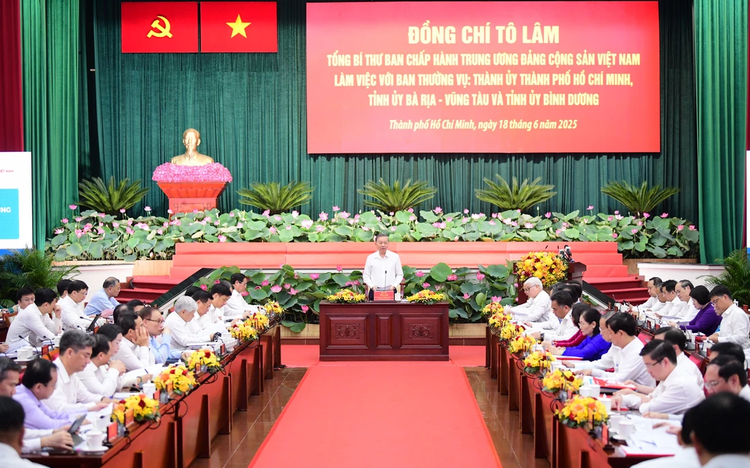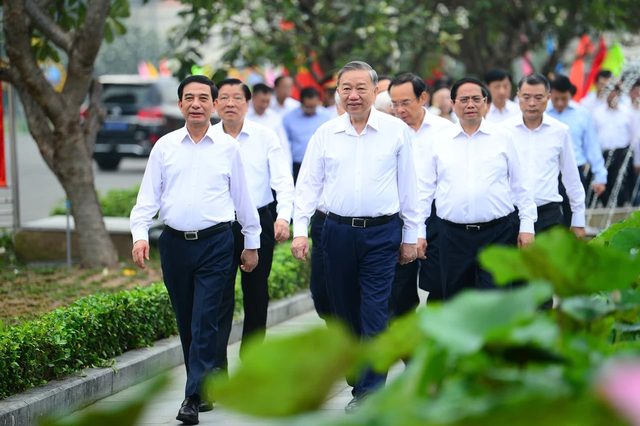
Party General Secretary To Lam works in Ho Chi Minh City. Photo: Quang Dinh / Tuoi Tre
At a working session with leaders from the three localities, Lam reviewed reports showing that each locality has built strong institutional foundations and digital governance models, placing them at the forefront nationally.
He praised their achievements but pointed to lingering obstacles that limit sustainable growth and international competitiveness.
The two provinces are set to merge with Ho Chi Minh City on July 1.
Ho Chi Minh City is facing serious constraints including limited development space, overloaded infrastructure, high population pressure, environmental degradation, flooding, and traffic congestion.
Lam called for a clear plan to eliminate substandard housing along canals and proposed modern solutions that better reflect the city's future direction.
In Binh Duong, urban development has lagged behind its rapid industrialization, creating disparities in living conditions.
Ba Ria–Vung Tau continues to struggle with regional connectivity and lacks a fully integrated logistics ecosystem.
Its tourism sector remains highly seasonal and underdeveloped in areas like smart services, luxury resorts, and health and wellness.
According to Lam, the imminent unification marks a historic shift in urban development.
It will create a powerful tri-polar city where Vietnam's financial, industrial, and maritime engines converge.
The future city will be a hub for commerce, technology, logistics, and tourism, built on principles of digital transformation, environmental sustainability, innovation, and social cohesion.
This new urban ecosystem must be more than a center for economic activity.
It should become a magnet for global talent, a center of creative thinking, and a model for public-private collaboration.
"The new Ho Chi Minh City must not only lead domestically, it must also secure its place on the global urban map," Lam said.
He proposed long-term goals for 2035 to 2045, challenging the city to define its future standing in Asia and worldwide in terms of income, innovation, and quality of life.
A new governance structure which is more robust than a provincial model yet more flexible than a regional one would be needed to manage this complex city of interconnected zones.
Lam stressed the need for integrated, intelligent planning with digital transformation embedded across public services, infrastructure management, and economic governance.
The city must shift to a knowledge-based economy rooted in innovation, with high value-added industries and competitive global standards.
He also urged officials to discard outdated concepts like 'inner-city versus outskirts' or 'centrally-governed city versus neighboring provinces.'
Instead, the new Ho Chi Minh City should function as a regional ecosystem with a multi-centered structure built on economic and functional integration.

Party General Secretary To Lam and officials at the working session in Ho Chi Minh City. Photo: Quang Dinh / Tuoi Tre
Key nodes such as Thu Thiem, Thu Duc, Di An, Ben Cat, Phu My, Ba Ria, and Vung Tau must be developed as interconnected parts of a flexible and coordinated system.
These zones should complement each other, sharing benefits and building a harmonious urban whole.
A central pillar of the vision is the creation of a strong science, technology, and entrepreneurial ecosystem.
Lam called for more than just slogans, instead he asked for real support for innovative businesses, global-minded entrepreneurs, and practical collaboration between universities, startups, investors, and incubators.
Given the city's young population, dense academic institutions, and global connectivity, Lam said Ho Chi Minh City must be Vietnam's most active implementer of innovation policies.
He proposed forming regional innovation centers, launching a public-private investment fund, and nurturing a new generation of socially conscious entrepreneurs.
"Ho Chi Minh City must be the place where every scientist, entrepreneur, or young person with a bold idea believes this is the best city to make it real," Lam said.
But beyond economic goals, Lam emphasized the importance of creating a livable and compassionate city.
Development must align with human well-being, social equity, and improved quality of life.
Investments in healthcare, education, youth development, and social welfare must ensure that no one is left behind.
To support this transformation, the city will need to build a regional transportation system that includes metro lines, expressways, and underground infrastructure.
It must also treat digital infrastructure as a strategic asset, with shared platforms and widespread use of artificial intelligence to enhance efficiency.
Ultimately, Lam said, the new Ho Chi Minh City must not just grow but it must lead to economically, socially, and culturally shaping the future of Vietnam as a regional and global force.


Max: 1500 characters
There are no comments yet. Be the first to comment.